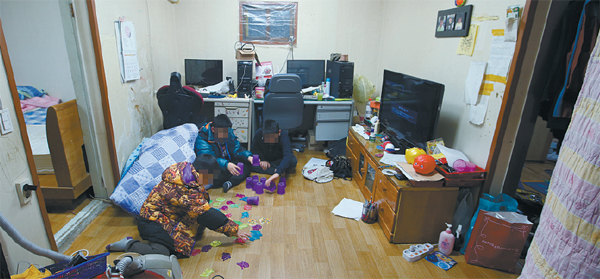Lacking day care, children left alone

Children play by themselves on Jan. 22 in their house in Pyeongtaek, Gyeonggi, while their parents are at work. Parents who work long hours are struggling to find after-school care for their children because the demand exceeds the capacity. By Park Jong-keun
The preteen, who lives in Pyeongtaek, Gyeonggi, then proceeded to play an online video game until his mother came home from work around 6 p.m.
The boy has two brothers, one a year older and the other one younger, and their routines are all the same.
They nearly always eat ramen for lunch to reserve as much time as possible in front of the screen.
Their mother, identified only by her surname Kim, tried to take her children to an after-school program, but they were denied admission due to her relatively high income. She makes 4.5 million won ($4,165) a month, but has to spend about 3.5 million won of that amount to take care of her hospitalized husband.
She explained her situation to school officials, but their answer remained the same.
“I have nowhere to turn to for child care,” Kim lamented. “I thought about getting them to attend cram schools, but it turned out to be too expensive because I would have to spend at least 150,000 won every month for each boy.”
The Ministry of Education is seeking to expand the number of after-school child care programs available, but it is far from meeting demand. And even still, such programs usually have strict requirements based on income levels.
About 3.7 percent of primary school children, or 122,351 out of 3.3 million, spend more than five hours alone a day, according to the Ministry of Gender Equality and Family.
That number far outnumbers the current capacity of Seoul’s school-based care programs, which can accommodate 11,876 elementary school students.
Children with single mothers are usually left alone longer than those with two parents.
One 8-year-old boy, who lives in Nowon District, northern Seoul, often spends his time alone until 8 p.m., playing with his Legos, though his mother sometimes comes home later because she works overtime for extra money.
And the mother of a 9-year-old girl, surnamed Baek, who lives in Gwanak District, southern Seoul, goes to work at 7 a.m. The girl often skips breakfast and lunch.
“My mom prepares meals for me, but I rarely eat them because it’s too much hassle,” she said.
Households with better financial status typically send their children to different, more sophisticated cram schools. Another 9-year-old girl, surnamed Chae, attends four different private institutes for English, taekwondo, piano and flute. When she finishes those classes at 6 p.m., her mother returns from work.
Chae’s friend said she also goes to three different hagwons.
Acknowledging the need for more child care programs, the Education Ministry announced last year that it will require schools to accept all first- and second-grade applicants at the start of March. Students in higher grades are not affected by the revised policy.
Meanwhile, experts have expressed concerns for these solitary children, many of whom spend time alone during their vacations as well.
“Some parents would think that leaving their children [home alone] would not cause serious problems,” said Choi Seok-hyun, director of the Good Maum Center, a nongovernmental organization dedicated to offering free psychological consultations to parents and children. “But if children are left alone for a prolonged period, they are more likely to go astray and their health tends to deteriorate.”
BY LEE YOO-JEONG [ejpark@joongang.co.kr]










with the Korea JoongAng Daily
To write comments, please log in to one of the accounts.
Standards Board Policy (0/250자)